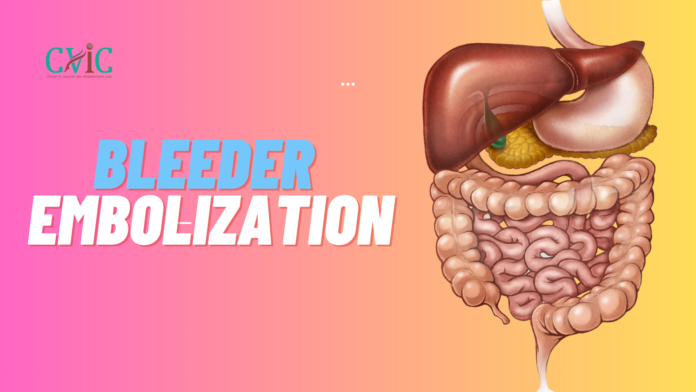Bleeder Embolization
Gastrointestinal bleeding is a medical emergency that requires swift and effective intervention to prevent life-threatening complications. Bleeder embolization has emerged as a crucial technique in the field of gastro-intervention, offering a minimally invasive approach to control bleeding and improve patient outcomes. In this comprehensive blog, we will explore the fundamentals of gastrointestinal bleeding, the role of bleeder embolization, the procedure itself, potential risks and benefits, and the future of this innovative intervention.
Understanding Gastrointestinal Bleeding
Gastrointestinal bleeding can originate from various parts of the digestive system, including the esophagus, stomach, small intestine, or colon. It can manifest as overt bleeding with visible symptoms like hematemesis (vomiting blood), melena (black, tarry stools), or hematochezia (bright red or maroon-colored stools). On the other hand, occult bleeding may be subtle and detected only through laboratory tests.
Common causes of gastrointestinal bleeding include peptic ulcers, gastritis, esophageal varices, diverticular disease, and colorectal polyps or cancer. Prompt identification of the bleeding source is crucial for effective management.
The Role of Bleeder Embolization
Bleeder embolization, also known as transcatheter arterial embolization (TAE), has become a key tool in the arsenal of gastro-interventional radiologists. This technique involves the selective occlusion of blood vessels supplying the bleeding site, thereby controlling hemorrhage without the need for open surgery.
The primary goal of bleeder embolization is to halt blood flow to the bleeding vessel, essentially blocking the source of hemorrhage. This is achieved by introducing embolic agents, such as particles or coils, into the blood vessels through a catheter. The choice of embolic material depends on factors like the location and size of the bleeding vessel.
The Procedure
Patient Evaluation
Before performing bleeder embolization, a thorough evaluation of the patient’s medical history, physical examination, and diagnostic imaging is conducted. This helps identify the bleeding source and assess the patient’s overall condition.
Angiography
Angiography is a diagnostic imaging technique that involves injecting contrast dye into the blood vessels to visualize their structure and identify the bleeding site. It provides real-time guidance during the procedure.
Catheterization
A catheter is inserted into the arterial system, usually through the femoral artery in the groin. The catheter is advanced under fluoroscopic guidance to reach the specific blood vessel supplying the bleeding site.
Embolic Agent Delivery
Once the bleeding vessel is identified, embolic agents are delivered through the catheter to occlude the vessel. These agents may include tiny particles, coils, or other materials that promote clot formation.
Post-Embolization Assessment
After embolization, angiography is performed again to confirm the successful occlusion of the bleeding vessel. This step ensures that the intervention has effectively controlled the hemorrhage.
Risks and Benefits
Like any medical procedure, bleeder embolization carries certain risks and benefits.
Benefits
- Minimally Invasive: Bleeder embolization is a less invasive alternative to open surgery, reducing the risk of complications and promoting quicker recovery.
- Rapid Hemostasis: The procedure provides rapid control of bleeding, preventing further blood loss and the associated complications.
- Suitable for High-Risk Patients: Bleeder embolization is often a suitable option for patients who are poor candidates for surgery due to comorbidities.
Risks
- Ischemia: There is a risk of unintended tissue damage due to reduced blood flow to surrounding tissues.
- Recurrent Bleeding: In some cases, bleeding may recur, necessitating additional interventions.
- Contrast-Related Complications: The use of contrast dye in angiography carries a small risk of allergic reactions or kidney damage.
Post-Procedure Care
After bleeder embolization, patients are closely monitored for any signs of complications or recurrent bleeding. In most cases, patients can resume normal activities within a relatively short period. However, individual recovery times may vary, and healthcare providers will provide specific guidelines for post-procedure care.
Future Directions and Innovations
The field of gastro-intervention is continually evolving, and ongoing research is exploring new techniques and technologies to enhance the effectiveness of bleeder embolization. This includes the development of novel embolic agents, improved imaging modalities, and refinements in catheterization techniques.
Furthermore, the integration of artificial intelligence (AI) into the interpretation of diagnostic images and procedural planning holds promise for optimizing the precision and success rates of bleeder embolization. AI algorithms can assist in identifying bleeding sources, determining the optimal embolic approach, and predicting patient outcomes.
Conclusion
Bleeder embolization stands at the forefront of gastro-intervention, offering a vital lifeline for patients experiencing gastrointestinal bleeding. As a minimally invasive alternative to traditional surgery, it provides a swift and effective means of controlling hemorrhage, ultimately saving lives. With ongoing advancements in technology and research, the future of bleeder embolization looks promising, holding the potential to further improve patient outcomes and solidify its place as a cornerstone in the management of gastrointestinal bleeding.
Our Doctors
Dedicated IR Center for Vascular Problems in Madhya Pradesh
DR. SHAILESH GUPTA
MD, PDCC (INTERVENTIONAL RADIOLOGY) Consultant & Co-Director CVIC (Center Of Vascular & Interventional Care)
DR. ALOK KUMAR UDIYA
MD Radiology, PDCC (Neurointervention Radiology), PDCC ( HPB Intervention Radiology) FINR (Switzerland) & EBIR
Endovascular Surgeon & Consultant Interventional Neuroradiologist at Care CHL Hospital, Indore Co-director CVIC( center for vascular and interventional care)
DR. NISHANT BHARGAVA
Consultant Intervention Radiologist
MD Radiology, PDCC ( Neurointervention Radiology), FINR ( Fellowship in Neurointervention Radiology)
Co-director CVIC(Center for Vascular and Interventional Care)
Contact Details
Phone no.
0731 4675670
+91 9827760073
Facebook
https://www.facebook.com/profile.php?id=100092538633553&mibextid=ZbWKwL
Instagram
https://instagram.com/cvic_center?igshid=ZGUzMzM3NWJiOQ==
Google My business
https://g.co/kgs/DrdV3T
YouTube
https://www.youtube.com/channel/UCP5TH5e4iQZkpDUgnLsgZhw
Pinterest
https://pin.it/5DzpX5Z
Twitter
https://x.com/cviccenter?t=01TclSrLFdu0K2re0Gs96w&s=08
LINKEDIN
https://www.linkedin.com/company/center-of-vascular-interventional-care/
Location –
Read More –
Mechanical Thrombectomy for Acute Stroke – https://cvicvascular.com/mechanical-thrombectomy-for-acute-stroke/
Pre-Operative Embolization of Tumors: A Lifesaving Strategy – https://cvicvascular.com/pre-operative-embolization-of-tumors-a-lifesaving-strategy/
Spinal AVM Embolization – https://cvicvascular.com/spinal-avm-embolization/




